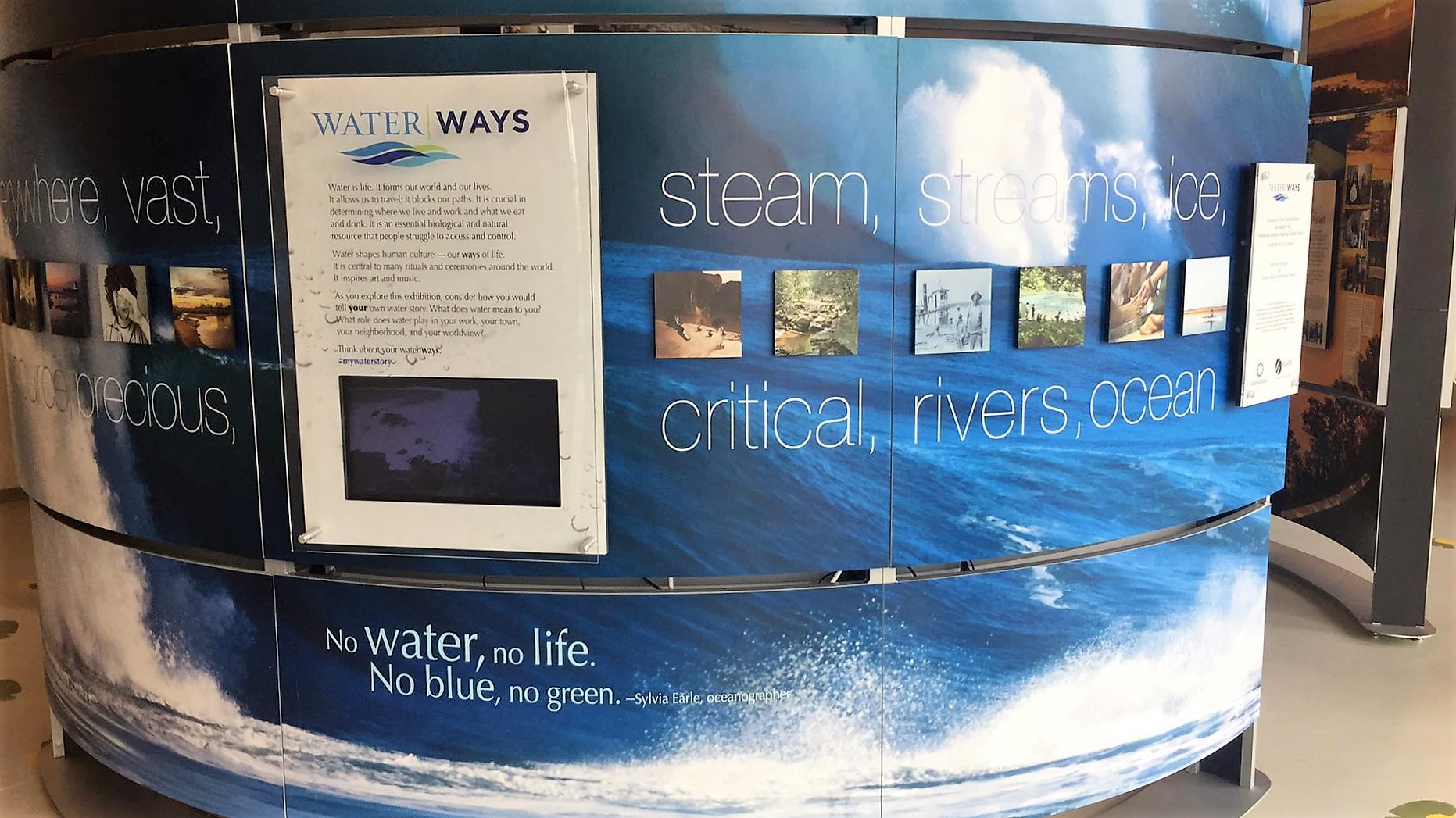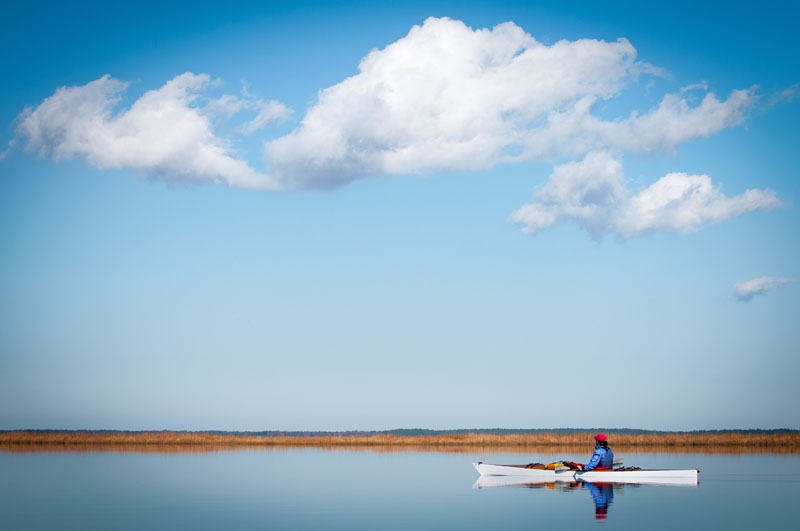
Although the COVID-19 pandemic has dramatically affected how museums operate, many, including the North Carolina Estuarium in Washington, are finding ways to continue educating the public.
The Estuarium, an environmental center at 223 E. Water St., is a nonprofit organization operated by Partnership for the Sounds and provides the opportunity to “Explore nature, history, and art in a fun, family-friendly center along the Pamlico-Tar River, in the heart of the Inner Banks.”
Supporter Spotlight
In keeping with the theme of exploring waterways, the Water/Ways traveling exhibition, which opened Oct. 16 and wraps up Nov. 29, looks at water’s impact on American culture.

The Estuarium is one of six rural sites chosen to host Smithsonian’s Water/Ways exhibit through its Museum on Main Street program.
“It went very well, other than the obvious difficulties in social distancing with kiddos,” Russ Chesson told Coastal Review Online about the opening weekend during the COVID-19 pandemic. Chesson is operations and programming specialist for the Estuarium.
“Some of our larger-scaled events have had to be canceled or reworked and we are not able to utilize the facility to its fullest extent,” Chesson explained. “We are lucky to have been on the cusp of opening our museum for the first time in months and gifted with the ability to welcome visitors and in-person programming. As with all things during the pandemic we have had to allow for smaller groups and follow recommendations to keep our people and patrons as safe as possible.”
Water/Ways, a series of standalone panels, is a part of Smithsonian’s Think Water Initiative to raise awareness of water as a critical resource for life through exhibitions, educational resources and public programs. The public can join in the conversation on social media with the #thinkWater hashtag.
Supporter Spotlight
The exhibition not only looks at the water cycle, water’s effect on landscape, settlement and migration, and its impact on culture and spirituality, but also how political and economic planning have long been affected by access to water and control of water resources.

The North Carolina Humanities Council helped bring the exhibit to the state.
“We are proud to bring another Museum on Main Street Smithsonian exhibit to North Carolina,” said Sherry Paula Watkins, executive director of the North Carolina Humanities Council.
“Since 2010, the council has brought four nationally recognized Smithsonian exhibits to 24 small-town museums, libraries and historic sites in the state,’” she said. “This program exemplifies what can be done by harnessing and combining the prestige of the Smithsonian Institution, the decades of program expertise of the North Carolina Humanities Council and the unique histories of our rural North Carolina towns.”
The Water/Ways traveling exhibition began its tour in May in Burnsville in Yancey County, then traveled to Franklin and Wake Forest before arriving in Washington this month. The exhibit will travel to Wrightsville Beach Museum Dec. 4 through Jan. 18, 2021, before its final stop in Graham in Alamance County. Previous host site locations can be found at www.nchumanities.org.
“The panels delve into the social, cultural and physical importance of water in our world and increases awareness of this essential element,” Chesson explained. “The actual exhibit is just a piece of the puzzle though, as each site has been tasked to provide events and programs to help caste a specific light on the importance of water in their own communities.”
Chesson said that Girl Scouts in the North Carolina Coastal Pines Council from Beaufort and Martin counties joined in the opening day of the Water/Ways exhibit because they no longer could hold a big event they had planned.
“Their Camporee was canceled, so we offered the premier of our Water/Ways exhibit as a way to fill in for what would have been a big night out weekend for them,” he said.

Kim Boyd, Girl Scouts service unit manager for Beaufort and Martin Counties and a troop leader, told Coastal Review Online that about four troops were represented from the two counties on the exhibit’s opening day.
Her daughter, Courtney Boyd, a senior at Southside High School in Chocowinity, was to plan the camporee at Camp Hardee but the camp is closed because of COVID-19.
Boyd said her daughter wanted to have a river-themed camporee at Camp Hardee, so they worked together to find an alternate location. they chose the Estuarium because it fit with the river theme and was in their backyard.
She said they were among the first to see the Water/Ways exhibit “and it was pretty great.”
The Scouts took COVID-19 precautions, including wearing a mask and only allowing 20 people in the exhibit at a time. After looking at the exhibit, the Scouts participated in two crafts projects. They learned more about what is found in a river and used river rocks to paint “kindness rocks.”
As part of the local programming, the Estuarium partnered with the BHM Regional Library in Washington to host book clubs aboard the center’s pontoon boat in October. The NC Humanities statewide read, “The Water Knife” by Paolo Bacigalup, is a book that resonates with the Water/Ways exhibit and with educational efforts at the Estuarium, Chesson said.
“In light of current educational settings, we are offering after-school nature craft programs every Wednesday in November,” he said. “’Water Way Wednesdays’ is designed to give the kiddos in our community an outside source of learning and hands on fun. All of our programs will include a viewing of the exhibit and discussion to further message of the importance of the blue in our blue planet.”
Chesson explained that he likes to teach his classes “about the magic of water as the holy trinity of molecules — the stuff of life. I feel like we may have a tendency in coastal communities to forget how close we are to it and how special we are for it. I’d like for our visitors to walk away with a new or reimagined awe for water and all its possibilities.”
“Creating personal connections with our local waterways is extremely important for supporting active stewardship of these waters,” said Christy Perrin, the sustainable waters and communities coordinator for North Carolina Sea Grant and a leader in the NC Watershed Stewardship network. “Hopefully visiting the exhibits and related events will inspire people to get out and explore their own local waterways.”
Chesson said David Clegg, chairman of the Estuarium board of directors, came across the opportunity with the North Carolina Humanities Council and The Smithsonian’s Museum on Main Street.
“Our director Tom Stroud thought that it seemed like a perfect for our museum and our message so he applied for the grant and the opportunity to host the exhibit,” he said.
The exhibition is a collaboration between the Smithsonian Institution Traveling Exhibition Service, state humanities councils across the nation and local host institutions. Sponsors include the National Humanities Center, Our State Magazine, Sea Grant North Carolina, North Carolina Museum of Natural Sciences and North Carolina Water Resources Research Institute.









